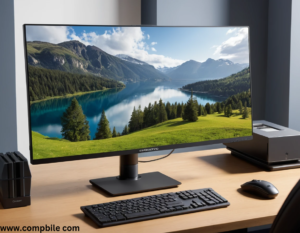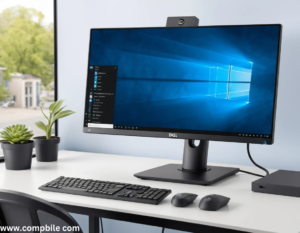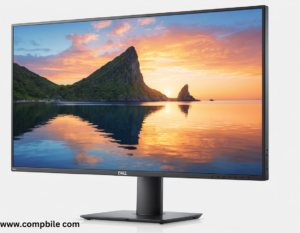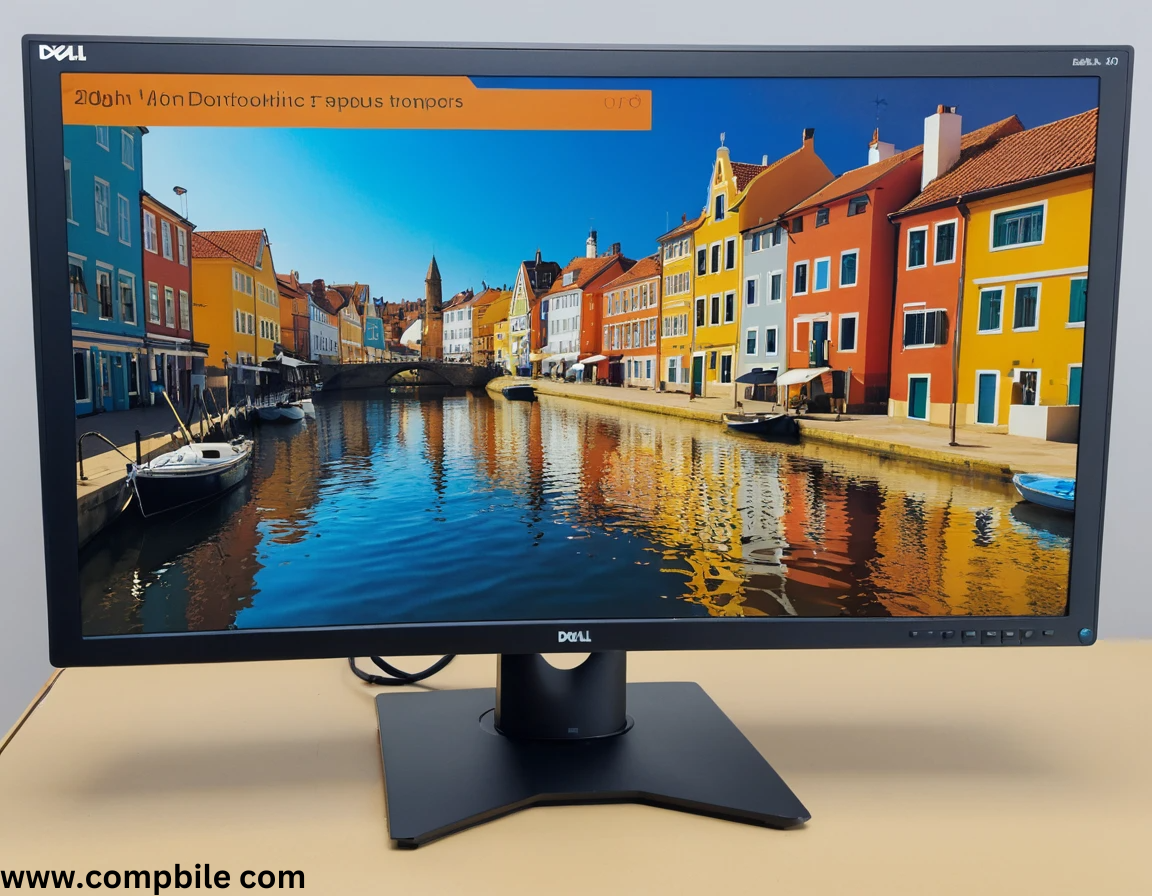Key Features:
- Dell 20 Monitor E2020H ⇒ Screen Size: 20 inches
- Resolution: 1600 x 900 (HD+), providing a crisp and clear display for everyday tasks.
- Panel Type: TN (Twisted Nematic), which offers fast response times but has limited viewing angles compared to IPS panels.
- Aspect Ratio: 16:9, which is standard for most modern displays.
- Brightness: 200 nits, which is suitable for most indoor environments.
- Response Time: 5 m s, making it relatively quick for general tasks and casual gaming.
- Refresh Rate: 60 Hz, which is standard for most office applications and multimedia.
- Ports: Includes VGA and HDMI ports, allowing connectivity to various devices.

Design:
- Thin Bezels: Offers a modern, streamlined look, making it suitable for multi-monitor setups.
- Tilt Adjustability: The monitor can be tilted to adjust the viewing angle, providing flexibility for ergonomic comfort.
Energy Efficiency:
- The monitor is Energy Star certified, indicating it is energy efficient, which helps reduce power consumption.
Display Quality:
- Resolution: At 1600 x 900 pixels (HD+), the E2020H offers a resolution that’s slightly higher than standard HD (720p) but lower than Full HD (1080p). This makes it suitable for office productivity, web browsing, and casual video watching, but it might not provide the sharpest visuals for media professionals or gamers who require higher pixel densities.
- Panel Technology: The TN (Twisted Nematic) panel is typically chosen for its fast response time and lower cost. However, TN panels generally offer poorer color accuracy and narrower viewing angles compared to IPS or VA panels. The E2020H’s TN panel, while not as vibrant, is more than adequate for typical office and general computer use.

2. Connectivity:
- HDMI Port: This port allows the monitor to connect to modern computers, laptops, gaming consoles, and more. HDMI is widely used, and it ensures a stable digital connection for both video and audio (if supported).
- VGA Port: This is an older analog video connection, typically found on legacy devices like older computers or projectors. While it’s still included for compatibility reasons, HDMI is generally preferred for newer devices.
3. Ergonomics and Design:
- Tilt Adjustment: The monitor offers a tilt feature, enabling you to adjust the screen angle to reduce neck strain and find an optimal viewing position. However, it does not have height, swivel, or pivot adjustments, which are commonly found in higher-end monitors.
- VESA Mount Compatibility: The Dell E2020H is VESA 100mm x 100mm compatible, which means you can mount it on a wall or use an adjustable stand if desired. This is useful if you prefer to create a more flexible or space-saving workspace.
- Thin Bezels: The monitor features a modern design with relatively thin bezels, making it a good choice for dual or multi-monitor setups.
4. Performance:
- Response Time: The 5ms response time helps reduce motion blur, especially when moving windows or interacting with content. While it’s not as fast as some high-performance monitors (which might go as low as 1ms), it’s still good enough for typical productivity tasks, light gaming, and video streaming.
- Refresh Rate: 60Hz is standard for office displays and ensures smooth performance for general tasks, though it won’t provide the ultra-smooth experience required by high-end gamers or those using graphics-heavy software.
- Brightness: With a brightness of 200 nits, this is a typical specification for indoor use. It’s bright enough for most environments but may struggle in very bright or sunlit rooms.
5. Energy Efficiency:
- The Dell E2020H is Energy Star certified, meaning it meets strict energy efficiency standards. This makes it a good choice for reducing power consumption, especially if you’re using the monitor for long hours.
- Power Consumption: In typical operation, the monitor consumes around 15W of power, and it consumes less than 0.5W in power-saving mode, making it a green option for both home and office environments.

6. User Experience:
- OSD (On-Screen Display): The monitor comes with an OSD menu that allows you to adjust various settings like brightness, contrast, color balance, and input source. Dell’s OSD menus are relatively intuitive, and the buttons on the monitor are easy to navigate.
- Blue Light Filter: Dell often includes software or settings for reducing blue light exposure, which can help reduce eye strain during extended use.
7. Dimensions and Weight:
- Physical Size: With a 20-inch screen, it fits well in most spaces and is relatively compact, making it suitable for smaller desks or shared workspaces.
- Weight: The monitor weighs about 2.7 kg (5.9 l bs), which is fairly lightweight for a monitor of its size.

8. Limitations:
- Limited Color Accuracy: Due to its TN panel, color reproduction is less accurate and vibrant compared to more advanced panels like IPS or VA. This is something to consider if you’re working on tasks that require precise color accuracy (like graphic design or video editing).
- Viewing Angles: TN panels have limited viewing angles. This means the screen might appear washed out or distorted when viewed from an angle, which can be a disadvantage for collaborative work or presentations.
9. Pros:
- Affordable and budget-friendly.
- Energy-efficient and eco-friendly with Energy Star certification.
- Reliable for everyday office tasks, web browsing, and media consumption.
- Compact size with a modern design, ideal for smaller workspaces.
- VESA mount compatibility for flexibility in setup.
10. Cons:
- The TN panel limits color accuracy and viewing angles.
- Fixed tilt adjustment (no height or swivel adjustment).
- Limited resolution compared to modern 1080p or 1440p displays.
- Not ideal for gaming or high-end media production.
Additional Technical Specifications:
1. Display Specifications:
- Contrast Ratio: 600:1 (typical). This ratio means the monitor’s darkest blacks are 600 times darker than the brightest whites. While it’s lower than the contrast ratios seen in higher-end monitors (which can reach 1000:1 or higher), it’s still sufficient for general use.
- Color Gamut: Being a TN panel, the Dell E2020H has a relatively narrow color gamut. It covers only a fraction of the sRGB color space, which may result in less vibrant colors. However, this is not a significant issue for regular office work.
- Pixel Pitch: 0.277mm. This refers to the distance between individual pixels. A smaller pixel pitch usually means sharper images, and the Dell E2020H’s pixel pitch is fairly standard for a monitor of this resolution and size.

2. Stand and Mounting Options:
- Height Adjustment: Unfortunately, the Dell E2020H lacks height adjustability, which means you can’t raise or lower the screen for the best ergonomic positioning. This is a limitation compared to more premium models.
- Tilt Only: As mentioned, this monitor offers tilt adjustment, so you can tilt it up or down to achieve a better viewing angle. However, if you require a monitor that can swivel, pivot, or adjust in height, you would need a different model with more ergonomic flexibility.
- VESA Compatibility: The E2020H is compatible with VESA 100mm x 100mm mounting standards, so you can mount it on a compatible stand or wall mount. This is particularly helpful for users with limited desk space or for those who want to create a dual or triple-monitor setup.
Get article on pdf file… click now
………….. Dell 20 Monitor E2020H …………

